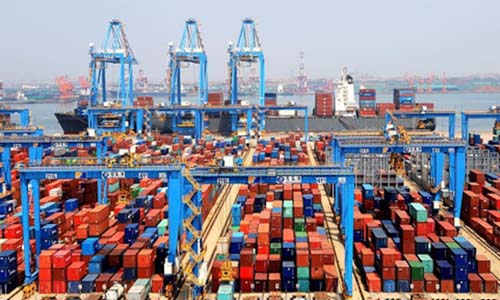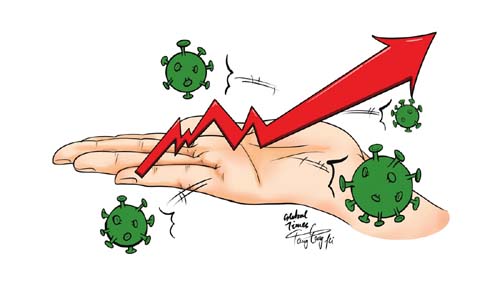
Talking China down will again fall flat
Wang Wen
Recently, many international financial institutions have continued to downgrade China’s economic growth forecasts. Badmouthing China is not something new, and China’s economy is indeed facing a lot of downward pressure due to factors like the COVID-19 epidemic.
But objectively speaking, these pessimistic opinions are based on either groundless accusations or exaggeration to deliberately create an anxious and fearful sentiment for global capital and exacerbate the fluctuation of China’s economy and finance.
In fact, those voices from the West that talk down China’s economy may seem to be very assertive, but they cannot subvert the three constant trends of China’s economic development from a long-term perspective.
First, China’s economy remains resilient and its position as the engine of the global economy is unshakeable.
Several data show that China’s economy and finance development steadily remains an unchanged trend. China’s GDP grew 4.8 percent year-over-year in the first quarter of 2022 (Q1 2022), up by 1.3 percent from the previous quarter. At the same time, China’s non-financial outbound direct investment grew by 6.3 percent on a yearly basis to 170.95 billion yuan ($25.7 billion). The total value of China’s exports in Q1 2022 was 5,226 billion yuan ($785 billion), up by 13.4 percent; that of imports was 4,189.1 billion yuan ($629 billion), up by 7.5 percent.
Although the current situation at both home and abroad has increased uncertainty, China’s economic volume and the long-term inertia of developments have given the nation’s economy a strong pressure resistance. China’s economy will continue to see solid growth and contribute 20-30 percent of global economic growth.
Second, the Chinese market is still favored by capital and such an advantage has not changed.

In Q1 2022, foreign direct investment (FDI) continues to flow into China, as the actual use of FDI expanded 25.6 percent year-on-year to 379.87 billion yuan ($57 billion). Data also showed that FDI in high-tech manufacturing rose 35.7 percent from the same period one year ago, while that in the high-tech services sector surged 57.8 percent year-on-year. FDI flows into China’s eastern, central and western regions grew by 23.4 percent, 60.7 percent, and 21.9 percent year-on-year respectively. During this period, a total of 21 provincial regions in the country achieved double-digit year-on-year growth in the actual use of FDI.
From this point of view, even though the appeal of certain regions in China to foreign investment is declining, it still does not hinder the appeal of China as a whole. The country remains one of the most popular investment destinations for international capital in the world.
Third, China’s industrial chain is still well integrated and irreplaceable as the most competitive industrial system in the world.
Based on the industrial classification of the United Nations (UN), China enjoys a comprehensive modern industrial system comprising 41 large industrial categories, 207 medium ones, and 666 small ones. It is the only country in the world to obtain all the industrial categories listed in the UN industrial classification.
China can enter both upstream and downstream sectors of various industries around the globe. This has made China competitive because it enables the country to have the ability to deeply engage in the global industrial supply chain in terms of manufacturing.
The “comprehensive” range of industrial categories lays a foundation for the development of China’s manufacturing sector, while increasing the scale of manufacturing provides a basis for its effective promotion into the international market.
In 2021, China’s value-added output of the manufacturing sector reached 31.4 trillion yuan ($4.97 trillion), accounting for 27.4 percent of its GDP. Since 2010, this indicator has been the world’s biggest for 12 consecutive years.
Parts of China’s manufacturing sectors have indeed been relocated overseas according to the basic law of comparative advantage and gradient transfer. But the transfer mainly happens in industries that are either labor-intensive or related to the primary processing of minerals, and this is not enough to reduce the competitiveness of China’s well-integrated industrial chain.
In addition, some of the relocations of industries happened due to the effect of “counter-cyclical” adjustment under the guidance of China’s policy. Many of China’s economic sectors are upgrading their industrial structure, relying on the country’s comprehensive range of industrial categories. Some regions and industries are also improving their production efficiency and optimizing their industrial layout.
All in all, the pessimistic opinions in the Western media on the Chinese economy are exaggerated. However, on the other hand, it rings an alarm bell for Chinese research institutions: It reminds us that to shatter these false statements, we need to manage our expectations effectively, dare to speak out in the international public opinion arena, and strengthen communication with the global community.
The writer is a professor and executive dean of the Chongyang Institute for Financial Studies at Renmin University of China
